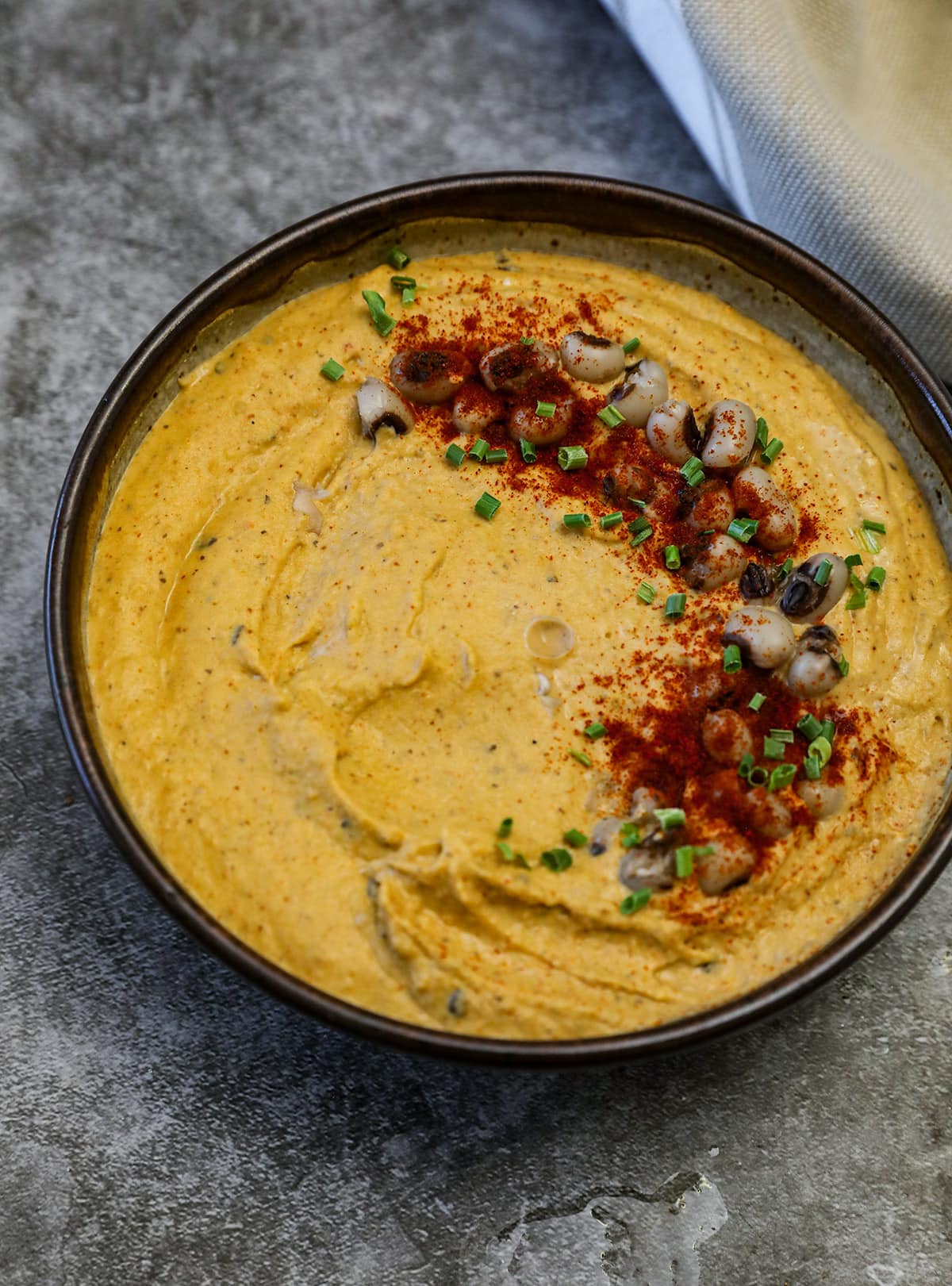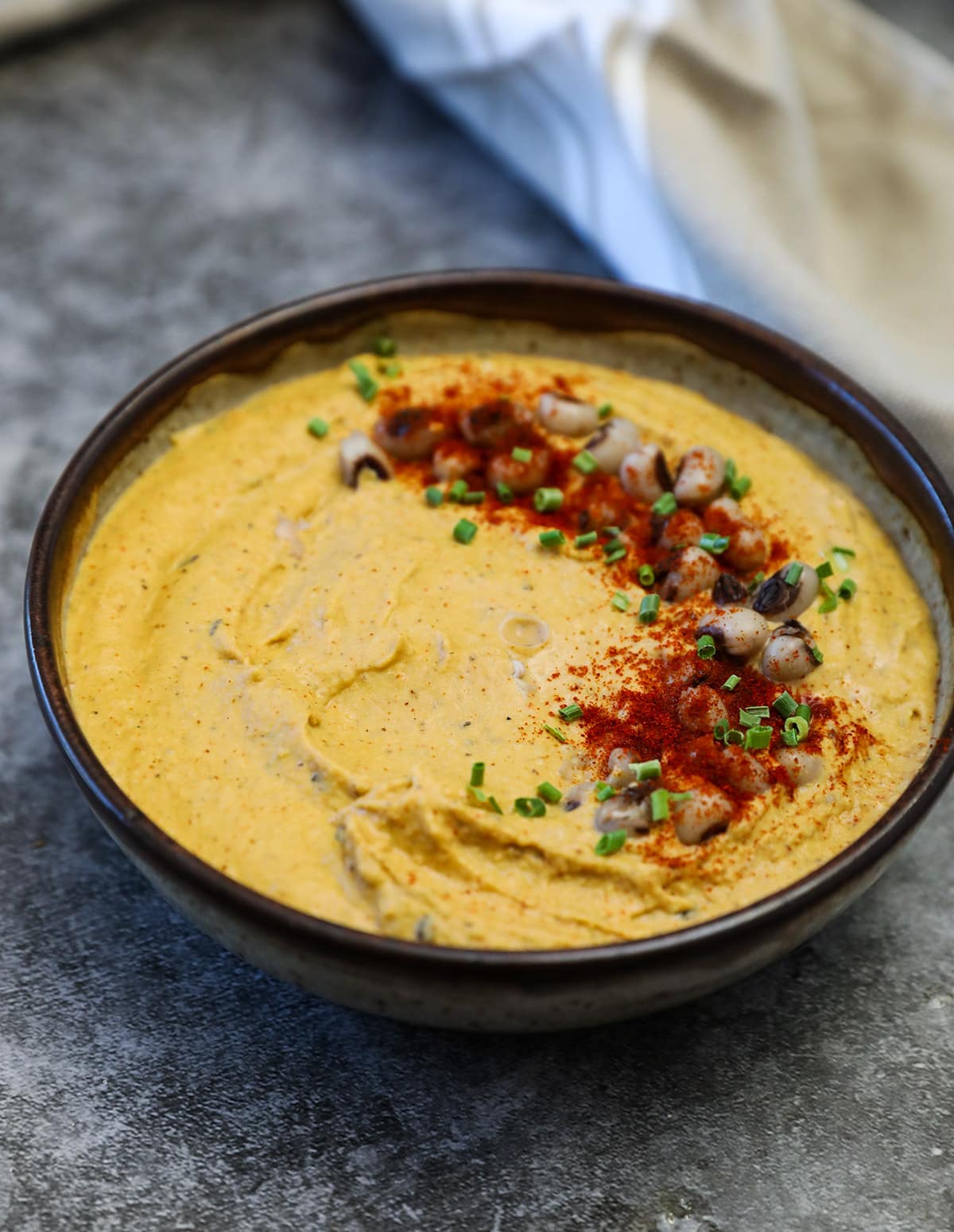Black Eye Pea Hummus
I’ll bet you have had regular hummus made with chickpeas or garbanzo and tahini, a sesame seeds paste. However, you may be unfamiliar with this delicious, flavorful, and nutritious black-eyed pea hummus. It is made with everyday grocery store ingredients, but it is simple and easy to prepare — ideal for both professional chefs with busy schedules and people who don’t want to spend a lot of time in the kitchen.
In Southern cuisine, black-eyed peas are widely considered a staple ingredient, having a strong, savory flavor.
“Hummus did not originate in the South. However, substituting chickpeas with black-eyed peas turns it into a dish that Southerners feel proud to serve!”
According to folklore, on New Year’s Day, eating black-eyed peas is supposed to bestow prosperity and fortune in the year ahead. This recipe of black-eyed pea hummus would be worth adding to your collection, whether you are a believer in this folklore or not.
Black-Eyed Pea Hummus goes well with sandwiches, crackers, or raw vegetables. Consider using this hummus in place of any other fatty spread to get yourself back in shape. And, a simple side salad will make a delicious meal.
Scroll down for the detailed recipe of Black-Eyed Pea Hummus, grocery list, and much more! But don’t skip reading the nutritional facts and health benefits of black-eyed peas.
If you are a hummus lover like me, you will also love How To Make The Best Hummus and Roasted Red Pepper Hummus.

Nutritional Facts
Black-eyed peas are highly nutrient-dense, with each serving containing a good amount of fiber and protein. Additionally, they have different essential micronutrients, notably folate, zinc, copper, iron, magnesium, and thiamine.
Potential Health Benefits
Here are some of the black-eyed peas’ potential health benefits:
Helps in Weight Loss
Black-eyed peas contain complex carbs that digest slowly than simple carbohydrates. As a result, those who use them may have more prolonged feelings of fullness, which may help weight loss.
Improve Optimal Digestion
Due to their high fiber content, black-eyed peas can improve digestion by facilitating regular bowel movements. This may be especially beneficial for individuals who suffer from occasional constipation. Additionally, black-eyed peas include prebiotic fiber, which provides food for good bacteria in the gastrointestinal tract.
Enhance Cardiovascular Health
Eating black-eyed peas as part of a healthy diet is a great way to keep your heart strong and healthy, as they may help in reducing various risk factors of cardiovascular diseases.
Evidence shows that frequently eating legumes may be beneficial for lowering LDL or “bad” cholesterol. Lowering high cholesterol levels can help lessen your chance of developing heart disease.
Eating legumes on a regular basis has also been associated with decreased inflammation markers, which may help lessen the chance of heart disease.
Boost Energy Level
Black-eyed peas are enriched with magnesium and will provide you with over 21% of your daily magnesium needs with just 1 cup of cooked peas.
Manganese is a powerful antioxidant that helps shield your cells, especially those in your energy production units. Black-eyed peas’ protein content also contributes to boosting your energy levels.
Good for Eyes and Skin Health
Black-eyed peas contain a good amount of vitamin A. Black-eyed peas provide one-fourth of an adult’s daily vitamin A requirement in one serving.
Vitamin A contributes to the eyes and skin health by lubricating and protecting the mucous membranes surrounding them.
Black-Eyed Pea Hummus Recipe
For making this delicious, thick, creamy black-eyed pea hummus, you need a few simple grocery store ingredients and a few simple steps to follow, and you have done!
Prepare/Cook Black-Eyed Peas
Canned black-eyed peas are an excellent option. However, if you’re going to use dried black-eyed peas, you’ll need to soak them first (overnight or at least 3-4 hours). This step significantly reduces cooking time.
In a big pot, add the peas with enough fresh water. Bring it to a boil and cook for around 40 minutes, or until tender. Rinsed and drained.

Ingredients
- Black-eyed peas – use dried peas that you soak and cook or use canned black-eyed peas, drained.
- Tahini-sesame paste -can be found in Middle Eastern supermarkets or you can make your own from hulled sesame seeds.
- Olive oil – helps to make creamy hummus, however, if you are oil-free, just leave the oil out and replace it with water.
- Lemon juice – gives a refreshing boost of flavor to your hummus.
- Garlic – boosts the spicy flavor of your hummus.
- Creole seasoning – your black-eyed peas hummus won’t be the same without Creole seasoning, add this for a flavorful hummus with a Southern flavor.
- Cumin – gives a deep smoky flavor.
- Smoked paprika – more smoky flavor to your hummus.
- Cayenne pepper – Just enough spicy flavor, leave out if you can’t handle the heat.
- Water -filtered water is fine or substitute with the liquid from the cooked black-eyed peas.
- Salt – use Himalayan pink salt or sea salt.
Instructions
- Add black-eyed peas, tahini, olive oil, lemon juice, garlic, Creole seasoning, cumin, paprika, cayenne pepper, and water in a food processor.
- Process until the hummus is creamy. Season with salt to taste, and that’s it.
- Transfer hummus into a small bowl, garnish with some drizzle of olive oil, and sprinkle paprika.
Other Black-Eyed Pea Recipes
- Vegan Southern Black-Eyed Peas
- Black-Eyed Pea Salad
- Vegan Instant Pot Black-Eyed Peas
- Black-Eyed Pea Fritters
- Instant Pot Vegan Black Eye Peas Curry
Ways to Use Black-Eyed Pea Hummus?
Serve this dip chilled, but it also tastes delicious when warm. Pair it with soft pita bread, crackers, vegetables like carrots, celery. Toss a spoonful of it into your salad. It is also a delectable sandwich spread! It’s also delicious with roasted meat or grilled fish. The options are countless; explore them!
Chef’s Notes
- You may substitute equal portions of fresh (cooked from dry), canned, or frozen Black-eyed peas, as per your choice & availability.
- For a bit of spice, use ¼ teaspoon cayenne pepper. For a hotter dip, add more peppers, or use freshly chopped jalapenos.
- Tahini is a smooth sesame seed paste used in a variety of Mediterranean recipes, including traditional hummus.
- Don’t overlook Cumin, which is also often used in Mediterranean cuisine, gives a hearty flavor to Black-Eyed Pea Hummus.
- I didn’t try this recipe in a blender – I think it’s too thick to blend well. If you have a scraping attachment, I recommend using it to make the mixing process go easier. Otherwise, you can scrape the sides with a spatula.
- Refrigerate leftovers in an airtight container for 3-4 days. You may freeze hummus for up to 3 months in airtight containers. Allow at least overnight in the fridge to thaw before using.

If you enjoyed this post about Golden Honeydew and would love to see more, join me on Youtube, Instagram, Facebook & Twitter!
Get discounted copies of my cookbook here.
Fortunately, because of the Ads on our website, readers and subscribers of Healthier Steps are sponsoring many underprivileged families.
Want to Save This Recipe?
Enter your email & I’ll send it to your inbox. Plus, get great new recipes from me every week!
By submitting this form, you consent to receive emails from Healthier Steps.

Black Eye Pea Hummus
Equipment
Ingredients
- 1 1/2 cups black-eyed peas cooked and drained
- 1/4 cup roasted tahini paste
- 2 tablespoons olive oil
- 1 tablespoon lemon juice
- 2 cloves garlic chopped
- 1/2 teaspoon Creole seasoning
- 1/2 teaspoon cumin
- 1/2 teaspoon smoked paprika
- 1/4 teaspoon cayenne
- 1/4 cup water
- Salt to taste
Instructions
- Add black-eyed peas, tahini, olive oil, lemon juice, garlic, Creole seasoning, cumin, paprika, cayenne pepper, and water in a food processor.
- Process until the hummus is creamy. Season with salt to taste, and that’s it.
- Transfer hummus into a small bowl, garnish with some drizzle of olive oil, and sprinkle paprika.







What a delicious-sounding recipe! I will definitely be trying it out!
Let me know how you liked it when you do! please & thank you!
Ooh this sounds so yummy! I love hummus and am trying to find different ways to make it. Thanks for sharing!
I think homemade hummus is the best!
I absolutely love how this recipe combines tradition and taste! Black-eyed pea hummus is a delightful discovery.
Looks so good! I love hummus, so will surely try your version 😍
Thank you! I hope you like & enjoy my version. 😊
This black eye pea hummus looks delicious, I’d love to give this recipe a try!
Give it a shot and let me know how you like this recipe.
This hummus looks delicious. I’ve only used black eyed peas in soup so I must try this recipe.
This ones unique but a must try! It is so good! 😋
I love any kind of hummus so I’ll have to try making this with black-eye peas. The addition of the creole seasoning is a nice touch!
This one Is very delicious & I just love adding It to bread. Makin nice simple easy sandwiches.
It is interesting to try out different types of hummus. This one looks like a great twist on traditional chickpea hummus. So healthy too!
Definitely worth a try. I loved this homemade version more than the store bought.
I just love hummus. This version looks amazing. I need to keep it in mind for a tasty snack.
Worth trying
Alyee, thank you for your feedback, I’m happy you love it.